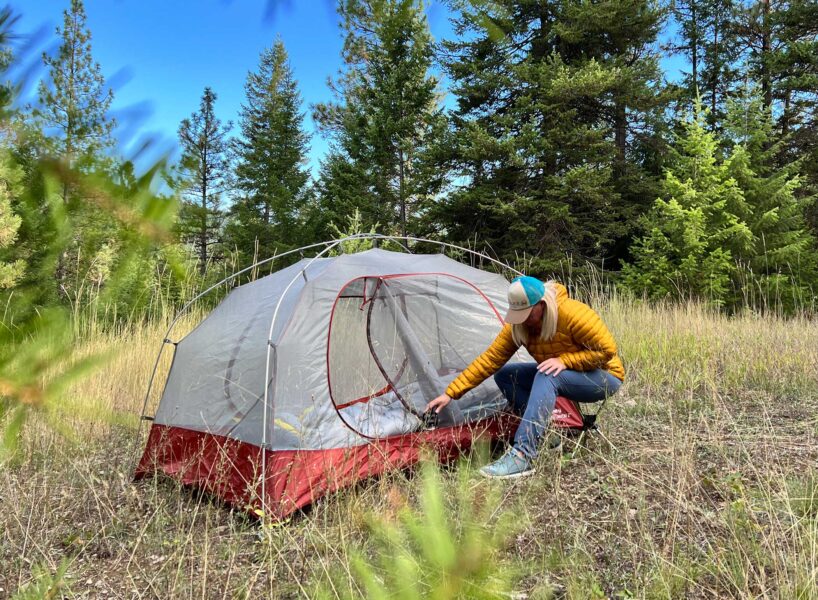
Image by Suzanne Downing
If you’ve ever owned a piece of Rab gear, you know the British outdoor brand represents quality and longevity. And they have some unique colors and designs. But the British brand also puts a major focus on sustainability and innovation. With their new Material Facts initiative, Rab is set to launch a new era of transparency and clarity in the realm of sustainable outdoor gear.
Just like you checking out how many calories are in your favorite snack, Rab’s leadership is letting you dive into what your outdoor gear is made of.
Beginning in September 2023, Material Facts will be an integral feature of all Rab apparel and sleeping bags, conveniently accessible online by scanning a QR code printed on the product hangtag. This initiative promises to demystify sustainability jargon and empower you (as a consumer) to make informed choices.
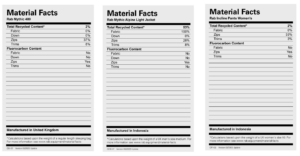
For example, if you’re checking out a Rab sleeping bag in a retail store, the Material Facts page spills the beans on what the sleeping bag is actually made of. Not just “fabric” — but the details. You’ll see the exact materials and even if they’re recycled. It’s like uncovering the mysteries of your gear’s DNA. Rab also offers interviews and behind-the-scenes stuff for those who want to dive even deeper into the gear world.
This Material Facts initiative is Rab’s way of being a trailblazer in the outdoor gear world. It’s like they’re saying, “Hey, we care about what you wear, and we want you to know all about it.”
Unlike brands that hide behind vague “green logos” and “eco-friendly” labels, Rab is taking a decisive stance on transparency. This data gives you an in-depth look into crucial aspects like fluorocarbon status (more on this below) and production details. This means you’ll no longer need to rely on cryptic symbols and generic claims when deciding to invest in Rab products.
Why Material Facts?
Behind this move stands Equip Outdoor Technologies Ltd., the parent company of both Rab and Lowe Alpine. Their leadership was fueled by frustration over the muddled landscape of sustainability criteria, so they pioneered the Material Facts sustainability information tables to establish a new standard of precision and openness.
Tim Fish, the product director at Rab, elucidates this vision.
“Transmitting sustainability information is a multifaceted challenge that holds diverse interpretations for different individuals. This often leads to deceptive assertions and ‘greenwashing,'” he said. “Our non-branded Material Facts program has been meticulously crafted to equip consumers with the knowledge they need to make well-informed purchases. The program sets a precedent by addressing the calls from consumers and retailers for trustworthy and accurate sustainability claims.”

The Material Facts initiative isn’t just about immediate change; it’s a catalyst for a broader movement. By the conclusion of 2024, Material Facts tables will extend beyond apparel and sleeping bags to encompass Rab and Lowe Alpine packs, equipment, and accessories. Moreover, future iterations of the initiative will encompass additional criteria, solidifying its role as a cornerstone of authentic sustainability representation.
In a world of buzzwords and dubious claims, Rab’s Material Facts initiative emerges as a guiding light. By embracing clarity, accuracy, and accessibility, Rab not only empowers consumers but sets a precedent for brands worldwide.
Fluorocarbon (PFC) Explained
On Rab’s Material Facts, the Fluorocarbon (PFC) Content takes up a lot of real estate under the Total Recycled Content section.
If you’ve never heard of fluorocarbons, imagine these as tiny, invisible helpers that some outdoor gear might have in it to help you stay dry when it rains. Fluorocarbons make water slide off gear, like when you used to slide down a slide at the playground.
But these little helpers (fluorocarbons) aren’t very friendly to the environment. They can stick around in nature for a long time and can even make animals and plants sick. It’s like leaving behind lots of microscopic trash that doesn’t go away easily.
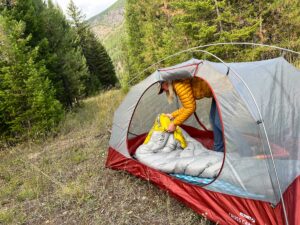
Image by Suzanne Downing
So, experts — who care about our planet and all the cool creatures that live on it, like polar bears and dolphins — say we shouldn’t use these fluorocarbons in our outdoor gear. They want manufacturers to find better, more Earth-friendly ways to keep our gear dry and comfy.
It’s kind of like picking up your camping gear and trash after camping — Rab is trying to be responsible and make sure their choices don’t harm the Earth. So, when you see outdoor gear that’s labeled “no fluorocarbons” or “fluorocarbon-free (PFC-Free),” it’s like a little high-five to nature.
Material Facts in Action
I field tested the Rab Women’s Mythic Alpine Light Down Jacket, Incline Pants and the Mythic 400 Down Sleeping Bag (20F). To get the Material Facts for each product from the hangtag, you simply select your phone’s camera and hover the QR code. Then, click the URL that the QR code directs you to and viola. You can see all the Material Facts associated with that product.
For the Mythic Alpine Light Down Jacket, I could see that it was made with 100 percent recycled fabric, 28 percent recycled material in the zippers, and 8 percent recycled material in the trim. You can also see all the material details on that page.
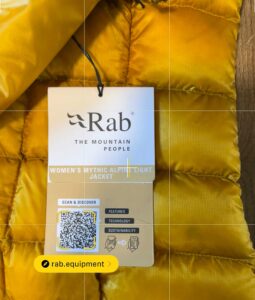
For this jacket, Rab’s product engineers focused the design on down-filled baffles on the core for maximum warmth, while the sides, cuffs, shoulders, and hood’s base employing synthetic insulation to create efficient moisture management and breathability.The use of premium insulation, featuring 900FP down and PrimaLoft® Gold, translates to exceptional warmth relative to its weight and size. This jacket excels in keeping you cozy without weighing you down.
You can imagine wearing this jacket during a ski touring escapade in the Swiss Alps just as much as wearing it to stay warm while camping in the mountains. When the sun sets behind mountain peaks and the temperature drops, this jacket is like being in a cacoon.
And for those conscientious about sustainability, the jacket doesn’t disappoint. The manufacturer’s commitment to transparency shines through as they divulge intricate material details and ethical production practices.
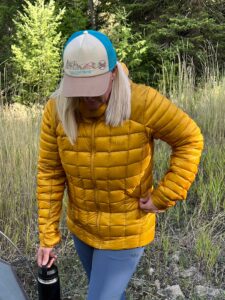
Image by Suzanne Downing
For the Rab Mythic 400 Down Sleeping Bag (20F) that’s tailor-made for alpine-style escapades where shaving off weight and bag size is key. You can see the Material Facts the same way — using your phone’s camera to hover over the QR code and clicking the URL.
You’ll learn that the sleeping bag is stuffed with 900FP goose down and wrapped in that lightweight Atmos ripstop fabric. You’ll also learn that the sleeping bag is manufactured in the United Kingdom. For performance, this sleeping bag is perfect if you’re someone who obsess over every gram, as it weighs in at just 660g on the scale and is great for chilly nights with a RAB sleep limit of -6°C (20°F).
The Rab Incline Pants bring a modern twist to outdoor adventures. Constructed from lightweight Matrix softshell, they embody stretch, breathability, and weather defense like the Incline AS Pant but in a lighter build for milder conditions. Think quick-drying, wind-resistant goodness. Imagine hiking the rugged Pacific Crest Trail. As the path gets gnarly, the pants’ stellar stretch and articulation keep you moving with ease. Topped with a shaped waistband, double snap fly, belt loops, and a drawcord hem, these pants battle boggy terrain and gusty winds. With three zip pockets, stowing essentials is hassle-free. Available in various leg lengths for practicality.
Suzanne Downing is an outdoor writer and photographer in Montana with an environmental science journalism background. Her work can be found in Outdoors Unlimited, Bugle Magazine, Missoulian, Byline Magazine, Communique, MTPR online, UM Native News, National Wildlife Federation campaigns and more.
 Your Privacy Choices
Your Privacy Choices
 The
The